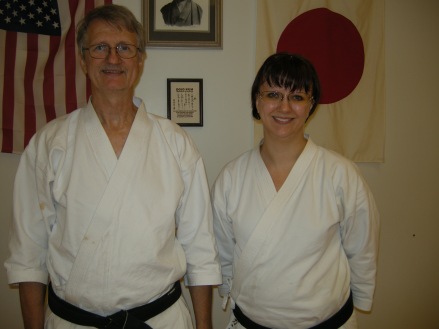
Karate has always been a part of Joel Ertl’s life, even before he knew what it was. No one could have predicted he would be helping Midwest Karate celebrate its 40th year at its Dayton’s Bluff location this October.
As a child in the 1960s, the Watkins, Minnesota, native first became intrigued with the word “Karate” on the big yellow sign he saw whenever his family made the trip to the big city: St. Cloud. They didn’t go inside or even stop, but that didn’t stop the youngster from thinking about it.
Ertl finally took his first lesson as a 15-year-old in 1973 at the St. Cloud studio. And he was hooked.
“All the details, the small details,” Ertl said. “It’s just fascinating.”
The coordinated movements in a discipline that people could keep learning over a lifetime appealed to Ertl. “There isn’t anything that isn’t thought out.”
Ertl began teaching at Midwest Karate’s St. Cloud location in 1976, just three years after taking up the discipline. In 1979, Ertl became the instructor at the Dayton’s Bluff location—where his future wife Anita was already a student—and has been there ever since.
The nurturing nature of the karate community created a welcoming atmosphere. At the time, his fellow students consisted mostly of men in their 20s and 30s, and only a few women, which mirrored the national profile. Kids were not considered capable of the challenge.
“I knew I belonged,” Ertl said of his first karate experience.
Ertl still belongs, even though his clientele has changed.
Women began getting more involved in karate in the 1970s. Interest grew as competitions began including women’s divisions. Finding practical applications also made the craft reach a broader audience. Anita currently teaches self-defense at the University of Minnesota and Macalester College.
Today, the number of men and women are about equal, and karate has become more of a family activity. Many kids start at age 7, which is when they have the concentration necessary for the discipline. Ertl allows younger students to join classes on a case-by-case basis.

The number of kids joining increased abruptly in the early 1980s with the release of The Karate Kid.
“Oh my gosh,” Ertl said. “We went from about six to eight kids to about 40.”
Also, in 1980, Ertl had 20 students total. “Now we have more blackbelts than that.”
The Dayton’s Bluff neighborhood has changed too, and that diversity has shown up in his karate classes. Sometimes, “I’m the only one who only speaks English,” Ertl said of a class that typically has about 20 students. Multilingual conversations are not uncommon, but one that stood out included students speaking to one another in German, Spanish, Somali, Japanese, and English.
“The East Side is one of the most diverse communities in the country,” Ertl said. “More importantly, they all get along.”
This might be due to the roots in the community, as there are now many third- and fourth-generation immigrant families. A couple decades ago, the neighborhood entered a transition after major employers Hamm’s, Whirlpool and 3M left the area in the 1980s. The repercussions of losing 15,000 jobs in the area included lower property values, a higher crime rate, more rental housing and a less stable community.
The East Side has been stabilizing and building back up faster than most people realize, according to Ertl, who speculates that the East Side might get a bad reputation because the neighborhood covers miles of space whereas most neighborhoods can be defined in terms of blocks. When newscasts mention “crime on the East Side,” they paint a diverse range of people and neighborhoods with the same brush.
Ertl believes the growth in Dayton’s Bluff has picked up even more in the last few years. New businesses like the Dancing Goat Coffee Shop, Tenacious Design + Social, and the Mississippi Market, have sprouted up while more established businesses like Flat Earth Brewing have expanded.
“The East Side has always gone up and down,” Ertl said, “but it really seems to be on the upswing now.”